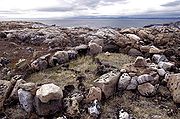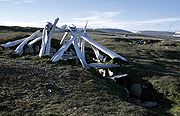
Qarmaq
Encyclopedia


Inuktitut
Inuktitut or Eastern Canadian Inuktitut, Eastern Canadian Inuit language is the name of some of the Inuit languages spoken in Canada...
term for a type of inter-seasonal, single-room family dwelling
House
A house is a building or structure that has the ability to be occupied for dwelling by human beings or other creatures. The term house includes many kinds of different dwellings ranging from rudimentary huts of nomadic tribes to free standing individual structures...
used by Inuit
Inuit
The Inuit are a group of culturally similar indigenous peoples inhabiting the Arctic regions of Canada , Denmark , Russia and the United States . Inuit means “the people” in the Inuktitut language...
. To the Central Inuit
Central Inuit
Central Inuit are the Inuit of Northern Canada, their designation determined by geography and their tradition of snowhouses , fur clothing, and sled dogs. They are differentiated from Alaska's Iñupiat, Greenland's Kalaallit, and Russian Inuit...
of Northern Canada
Northern Canada
Northern Canada, colloquially the North, is the vast northernmost region of Canada variously defined by geography and politics. Politically, the term refers to the three territories of Canada: Yukon, Northwest Territories, and Nunavut...
, it refers to a hybrid of a tent
Tent
A tent is a shelter consisting of sheets of fabric or other material draped over or attached to a frame of poles or attached to a supporting rope. While smaller tents may be free-standing or attached to the ground, large tents are usually anchored using guy ropes tied to stakes or tent pegs...
and igloo
Igloo
An igloo or snowhouse is a type of shelter built of snow, originally built by the Inuit....
, or tent and sod house
Sod house
The sod house or "soddy" was a corollary to the log cabin during frontier settlement of Canada and the United States. The prairie lacked standard building materials such as wood or stone; however, sod from thickly-rooted prairie grass was abundant...
. Depending on the season, the lower portion was constructed of snow blocks or stone, while the upper portion used skins or canvas. To the Kalaallit
Kalaallit
Kalaallit is the contemporary term in the Kalaallisut language for the indigenous people living in Greenland, also called the Kalaallit Nunaat. The singular term is kalaaleq. The Kalaallit are a part of the Arctic Inuit people. The language spoken by Inuit in Greenland is Kalaallisut.Historically,...
of Greenland
Greenland
Greenland is an autonomous country within the Kingdom of Denmark, located between the Arctic and Atlantic Oceans, east of the Canadian Arctic Archipelago. Though physiographically a part of the continent of North America, Greenland has been politically and culturally associated with Europe for...
, qarmaq refers to the dwelling's wall. Qarmaq were built in the transitional seasons of fall and spring with a circular wall of stone, sod, or blocks of snow, a framework usually made from animal bones, which were covered with a skin.
History
Qarmaqs were used by the Inuit up to the 1950s. They were used as early as the Thule peopleThule people
The Thule or proto-Inuit were the ancestors of all modern Inuit. They developed in coastal Alaska by AD 1000 and expanded eastwards across Canada, reaching Greenland by the 13th century. In the process, they replaced people of the earlier Dorset culture that had previously inhabited the region...
, predominantly during the cold season. In winter, they also lived in igloo, especially while traveling, but when possible, the qarmaq was the preference.
Architecture
Finding the appropriate site for the qarmaq included understanding the geological layout of an area in relationship to elements of weather. Its construction involved men, women and children.Snow qarmaq
Men collected and pieced together boulders and framework. Lacking timber, the framework was usually made of bone, preferably whale bone. Women and children gathered tundra moss for crevices, and prepared skins for roofing and siding. After winter snow arrived, the men used long knives to cut up blocks of snow, placing them in an outwardly direction for further protection. When the outer casing was attacked by the weather or gnawed on by wolves or foxes, women patched it up again and again, often with numb fingers in the freezing cold and biting wind.
Sod qarmaq
Summer tent living, which was easily portable, preceded the autumnal sod qarmaq.
Interior
Inside, qarmaqs offered warmth only by the flame of the qulliqKudlik
Kudlik or qulliq is a type of oil lamp used by the Inuit. The lamp consists of a crescent-shaped cup of carved soapstone, filled with oil from blubber or seal. Arctic cottongrass, common cottongrass, or moss is used as a wick....
. The sleeping area was slightly elevated and used caribou skin for padding.

